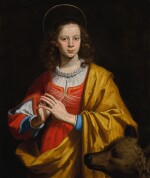
Property from a European Private Collection | 歐洲私人收藏
LORENZO LIPPI | Portrait of a young woman, probably Margherita Galli, in the guise of Saint Margaret | 洛倫索・利皮 | 《年輕女子肖像,應為瑪格麗塔・加利妝成聖瑪加利大》
Auction Closed
December 4, 08:03 PM GMT
Estimate
50,000 - 70,000 GBP
Lot Details
Description
Property from a European Private Collection
歐洲私人收藏
LORENZO LIPPI
洛倫索・利皮
Florence 1606 - 1665
1606 - 1665年,佛羅倫薩
Portrait of a young woman, probably Margherita Galli, in the guise of Saint Margaret
《年輕女子肖像,應為瑪格麗塔・加利妝成聖瑪加利大》
oil on canvas
油彩畫布
88 x 75 cm.; 34¾ x 29½ in.
油彩畫布
Possibly Agnolo Galli, Palazzo Galli, Via Pandolfini, Florence;
Anonymous sale, London, Sotheby's, 7 December 2006, lot 209, for £78,000.
F. Baldassari, La Pittura del Seicento a Firenze, Indice degli Artisti e delle loro Opere, Turin 2009, p. 448.
For much of his early career Lorenzo Lippi was apprenticed in the workshop of Matteo Rosselli, along with other painters such as Baldassare Franceschini, called il Volterrano, and Jacopo Vignali. Lippi did not open his own independent practice until 1634 and continued working in association with Rosselli until at least 1640. He was considered one of the principal painters in mid-seventeenth century Florence and was greatly esteemed by contemporaries, in particular his friend and biographer Filippo Baldinucci (1681–1728).
The beautiful sitter is possibly identifiable with one of the daughters of Agnolo Galli, who were depicted in Lippi's Triumph of David, dating from 1656, published by Chiara D'Afflitto as in a private collection, Florence.1 In the Florentine painting the sitter can be seen wearing the same clothes that she wears in the present work, playing the flute in the second row of maidens. This portrait, so characteristic of Lippi's ability to capture both physiognomy and psychological insight, formed part of a series of five or six pictures commissioned by Agnolo Galli in about 1656, depicting his daughters in the guise of saints and may be compared to the Saint Elisabeth of Hungary (of the same dimensions), which was listed by D'Afflitto as formerly with Giancarlo Baroni, Paris.2 While the animal depicted has been identified as a bear (and thus would make the sitter more likely to be shown in the guise of Saint Ursula), D'Afflitto described it as a dog, which is the traditional attribute of Saint Margaret of Cortona.3
The painting is accompanied by Chiara D'Afflitto's written expertise (available on request). She dates the picture to the second half of the 1650s.
1 C. D'Afflitto, Lorenzo Lippi, Florence 2002, pp. 297–98, no. 123, reproduced.
2 D'Afflitto 2002, p. 299, no. 124, reproduced.
3 Not to be confused with the more famous Saint Margaret of Antioch, whose traditional attribute is a dragon.
